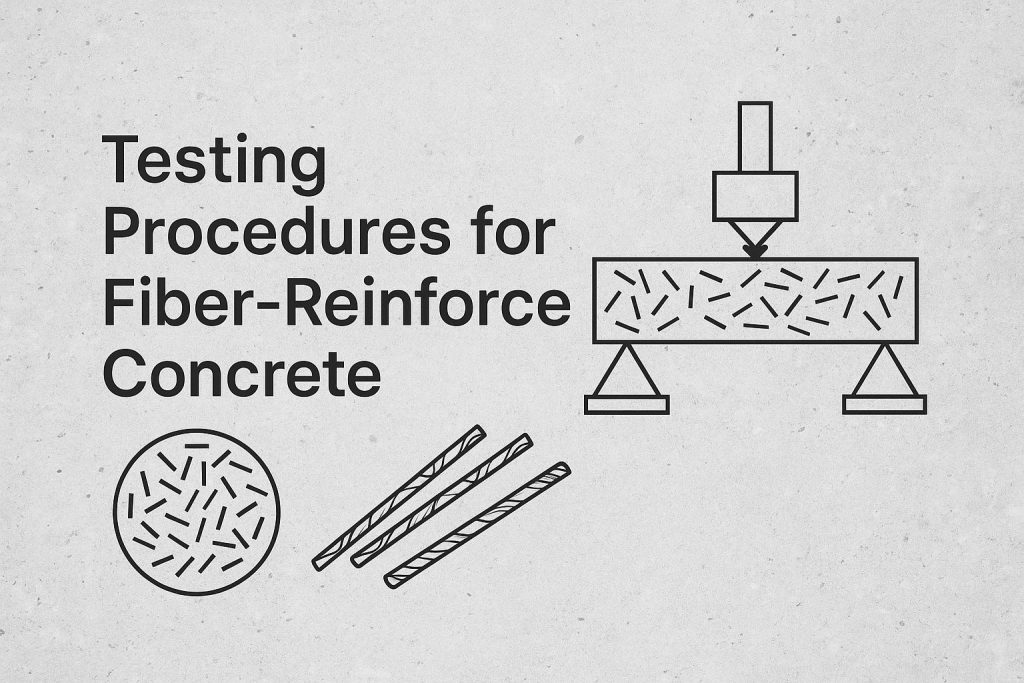

Testing Procedures for Fiber-Reinforced Concrete: A Gateway to Performance Optimization
Fiber-reinforced concrete (FRC) has emerged as a transformative material in modern construction, offering enhanced durability and tensile performance. Among its most critical mechanical advantages is the ability to improve post-crack load-bearing capacity, commonly referred to as residual tensile strength. This improvement enables concrete structures to maintain structural integrity even after crack formation.
To evaluate and quantify these mechanical contributions, specific international standards and testing methodologies are followed. These tests not only help in verifying product compliance but also serve as a foundation for fiber product development and innovation.
Key Test Standards for Fiber-Reinforced Concrete
Flexural Strength Determination
The baseline testing for concrete flexural behavior is governed by:
🔹 TS EN 12390-5: Testing hardened concrete – Part 5: Flexural strength of test specimensResidual Flexural Strength (Fracture Residual Stress)
To analyze the behavior of FRC beyond initial cracking, the following test standards are widely adopted:
🔹 TS EN 14651: Test method for metallic fiber concrete – Measuring the flexural tensile strength (limit of proportionality, residual strength)
🔹 ASTM C1609: Standard Test Method for Flexural Performance of Fiber-Reinforced Concrete (Using Beam with Third-Point Loading)In these methods, a fiber-reinforced concrete beam specimen is placed on two supports and loaded vertically at either one central point (3-point bending) or at two equidistant points (4-point bending). After cracking, the specimen’s ability to continue carrying load is recorded and analyzed. This residual load capacity is used to calculate the residual tensile strength, a key performance indicator of fiber-reinforced concrete.
Sample Preparation and Equipment Requirements
To carry out reliable testing under the standards mentioned above, specimen preparation must comply with several supporting standards:
- TS EN 12390-1: Shape, dimensions, and other requirements for specimens and molds
- TS EN 12390-2: Preparation and curing of specimens for strength tests
- TS EN 12390-4: Specification for testing machines used for compressive strength determination
To meet these requirements, the following equipment is essential for any FRC testing and development laboratory:
| Equipment | Purpose |
|---|
| Concrete Mixer | Homogeneous mixing of fiber-reinforced concrete specimens |
| Curing Tank/Chamber | Controlled curing of specimens to ensure standard consistency |
| 4-Point Flexural Test Machine | Measuring flexural strength and residual stress after cracking |
| Compression Test Machine | Determining compressive strength via cube or cylinder specimens |
The Role of Fiber in Enhancing Concrete Properties
The synthetic fibers we manufacture—primarily composed of polypropylene and polyethylene—are designed to improve concrete’s flexural behavior and residual tensile strength. These fibers bridge micro- and macro-cracks in the concrete matrix, thus improving ductility, energy absorption, and structural integrity under dynamic and static loads.
When properly tested using third-party laboratories, our fibers have proven effective in applications such as:
- Industrial floors and slabs
- Tunnel linings
- Precast elements
- Pavements and shotcrete
- Coastal and freeze-thaw exposed structures
Challenges in Product Development and Testing Access
Our flagship synthetic fiber product is certified with a Performance Consistency Certificate (KGS), validating its suitability for concrete reinforcement. However, ongoing R&D efforts for new product development are heavily reliant on testing capabilities. Currently, all mechanical tests—especially flexural and residual stress tests—are outsourced to third-party accredited laboratories.
This reliance introduces several challenges:
- High Testing Costs: Frequent third-party tests incur significant expenses.
- Delays in Data Acquisition: Test queue times and transport logistics slow down the feedback loop.
- Limited Iteration Capacity: Product iterations are restricted due to infrequent data collection.
A Call for Strategic Equipment Investment
Given our in-house expertise and commitment to fiber product innovation, equipping our R&D unit with the necessary testing devices (particularly a 4-point flexural test machine, concrete mixer, curing chamber, and compression test equipment) will significantly accelerate product development cycles.
By owning the equipment:
- Testing will be faster and more affordable.
- Continuous R&D can be conducted without external limitations.
- Accurate and timely data will enhance product refinement and commercial scalability.
- The company’s competitive edge and market share in advanced construction materials will grow.
Conclusion: Data-Driven Innovation for Smarter Concrete
Reliable mechanical testing is the cornerstone of developing high-performance fiber-reinforced concrete products. By integrating standardized testing procedures with strategic equipment acquisition, manufacturers can ensure consistent quality, push product boundaries, and meet the evolving demands of modern infrastructure.
Fiber-reinforced concrete is not just a material—it’s a system solution. And testing is the language that proves its worth.

